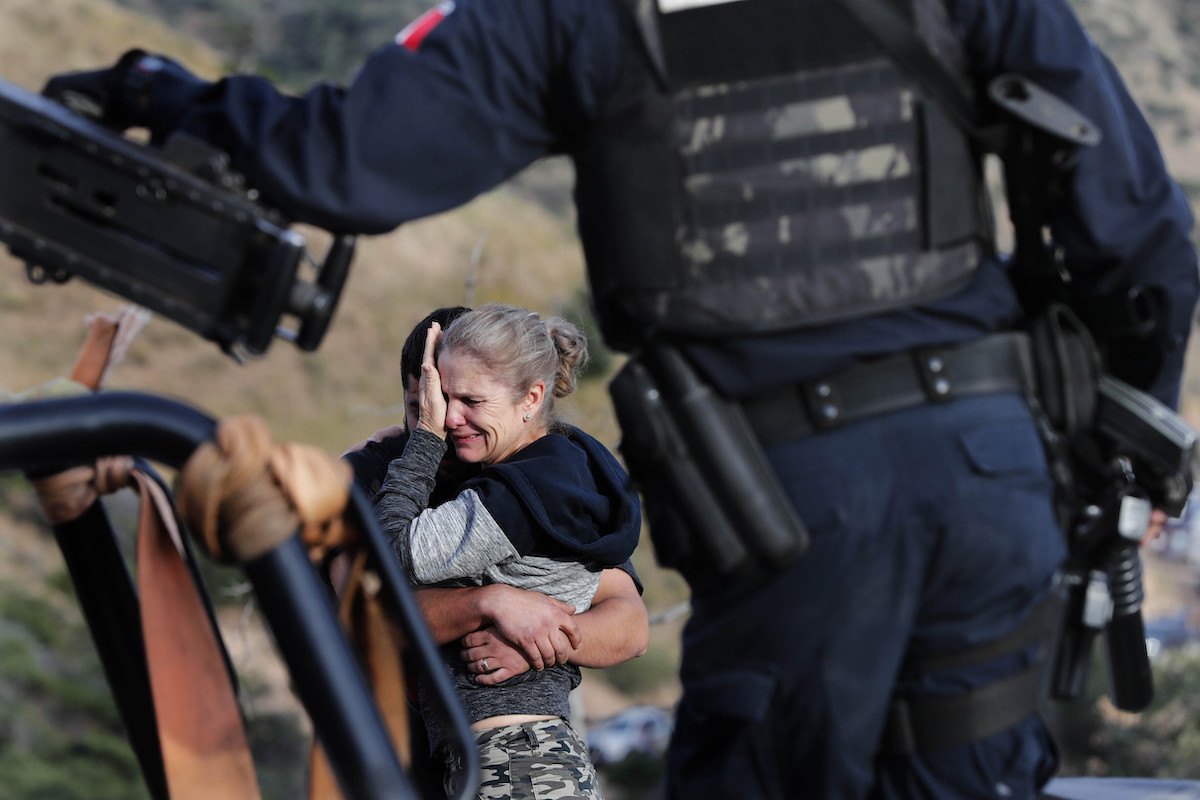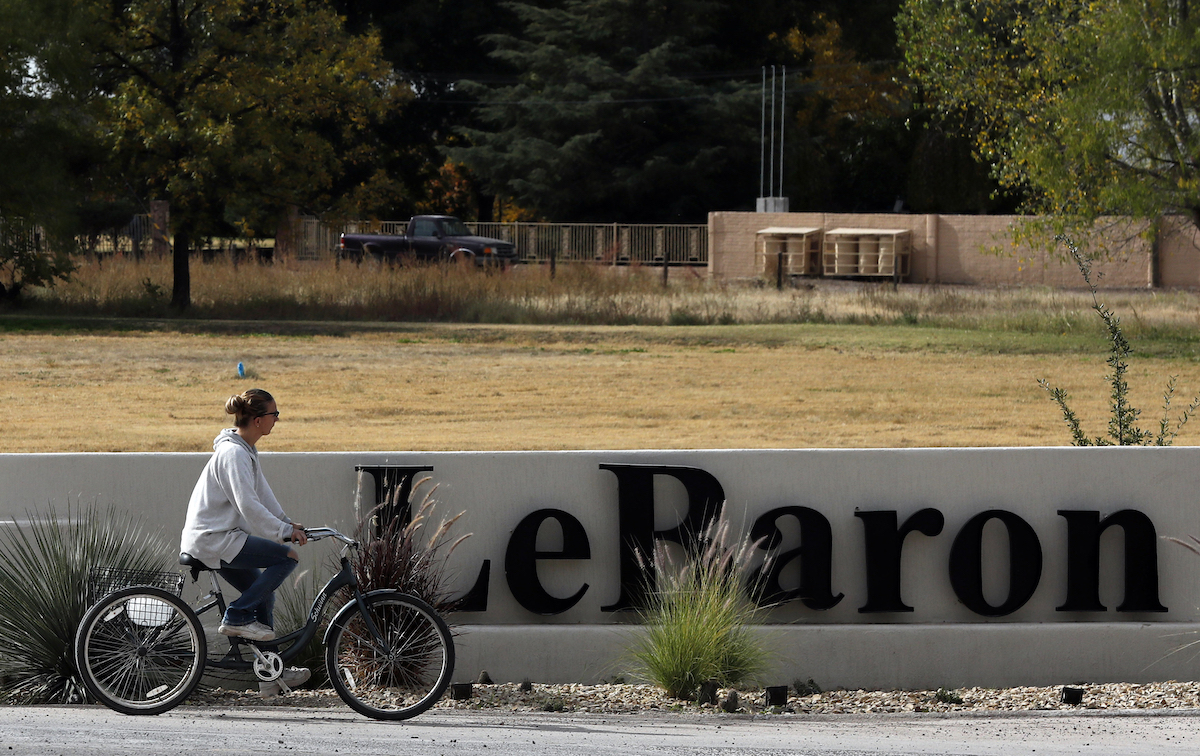

Framed by heavily armed Mexican authorities, relatives of the LeBaron family mourn at the site where nine U.S. citizens, three women and six children related to the extended LeBaron family, were slaughtered when cartel gunmen ambushed three SUVs along a dirt road near Bavispe, at the Sonora-Chihuahua border, Mexico, Wednesday, Nov 6, 2019. (AP Photo/Marco Ugarte)
By PETER ORSI, Associated Press
LA MORA, Mexico (AP) — With Mexican soldiers guarding the entrance to town, hundreds of people converged on this remote farming community for the first funerals Thursday for the nine American women and children killed by drug cartel gunmen.
Dozens of high-riding pickups and SUVS, many with U.S. license plates from as far away as North Dakota, bumped across dirt and rock roads over desert, arid grasslands and pine-covered mountains Wednesday as night fell on this community of about 300, where many residents are dual U.S.-Mexican citizens who consider themselves Mormon but are not affiliated with The Church of Jesus Christ of Latter-day Saints.
At least 1,000 visitors were expected to bunk down in the hamlet overnight ahead of Thursday’s funerals, filling floor space in the 30 or so homes or sleeping in tents they brought with them. At least one cow was slaughtered to help feed the masses as well as the few dozen soldiers guarding the entrance.
Steven Langford, who was mayor of La Mora from 2015 to 2018, said he expects the killings to have a major effect on the community.
At one time, he didn’t think twice about moving around the area in the middle of night, but in the past 10 to 15 years, things “got worse and worse and worse.” As many as half of the residents could end up moving away, he said.
“It was a massacre, 100% a massacre,” said Langford, whose sister Christina Langford was one of the women killed. “I don’t know how it squares with the conscience of someone to do something so horrible.”
Most of the victims of the ambush lived in La Mora, about 70 miles (110 kilometers) south of Douglas, Arizona.


Bullet-riddled vehicles that members of the extended LeBaron family were traveling in sit parked on a dirt road near Bavispe, at the Sonora-Chihuahua state border, Mexico, Wednesday, Nov. 6, 2019. (AP Photo/Christian Chavez)
When gunmen opened fire on them Monday, it took the Mexican army, the National Guard and Sonora state police about eight hours just to arrive.
To many, the bloodshed seemed to demonstrate once more that the government has lost control over vast areas of Mexico to drug traffickers.
And it called into question President Andrés Manuel López Obrador’s “hugs, not bullets” security strategy of trying to solve underlying social problems instead of battling drug cartels with military force.
It was also the latest shocking act of cartel violence to suggest that the old rules against killing foreigners, women or children are collapsing.
“The country is suffering very much from violence,” said William Stubbs, a pecan and alfalfa farmer who serves on a community security committee in the American-dominated hamlet of Colonia LeBaron. “You see it all over. And it ain’t getting better. It’s getting worse.”
Mexican officials said the attackers may have mistaken the group’s large SUVs for those of a rival gang. The Juárez drug cartel is fighting a vicious turf war against a faction of the Sinaloa cartel.
“Those who attacked the occupants, they let the children go, so we can deduce that it was not a targeted attack” on the families, said the army’s chief of staff, Gen. Homero Mendoza.
But Julian LeBaron, whose brother Benjamin, an anti-crime activist, was killed by cartel gunmen in 2009, said relatives found evidence that the attackers knew exactly who they were killing.
“They had to have known that it was women and children,” Julian LeBaron said. He said eight children who survived reported that one mother got out of her SUV and raised her hands and was gunned down anyway.


A woman cycles past a sign announcing the Colonia LeBaron, a community settled by members of the extended LeBaron family in Chihuahua state in northern Mexico, Wednesday, Nov. 6, 2019. (AP Photo/Marco Ugarte)
Mexican officials said that the first vehicle in the caravan —where four children and their mother died— may have burst into flames after its gas tank was hit by gunfire.
But LeBaron said shell casings were found very close to the SUV, and the mother’s checkbook was discovered about 10 yards (meters) from the wreck, suggesting that somebody approached the SUV before it burned, “which means the vehicle was not on fire and these people torched it.”
Langford said he and others come and go frequently between La Mora and the U.S., working north of the border to build lives and families in a place he described as a “paradise” for children to grow up. Behind the lot where he and his wife raised 11 children, they can go fishing and swimming.
“Now this place is going to become a ghost town,” he said. “A lot of people are going to leave.”
***
Associated Press Writer María Verza contributed to this report from Mexico City.


